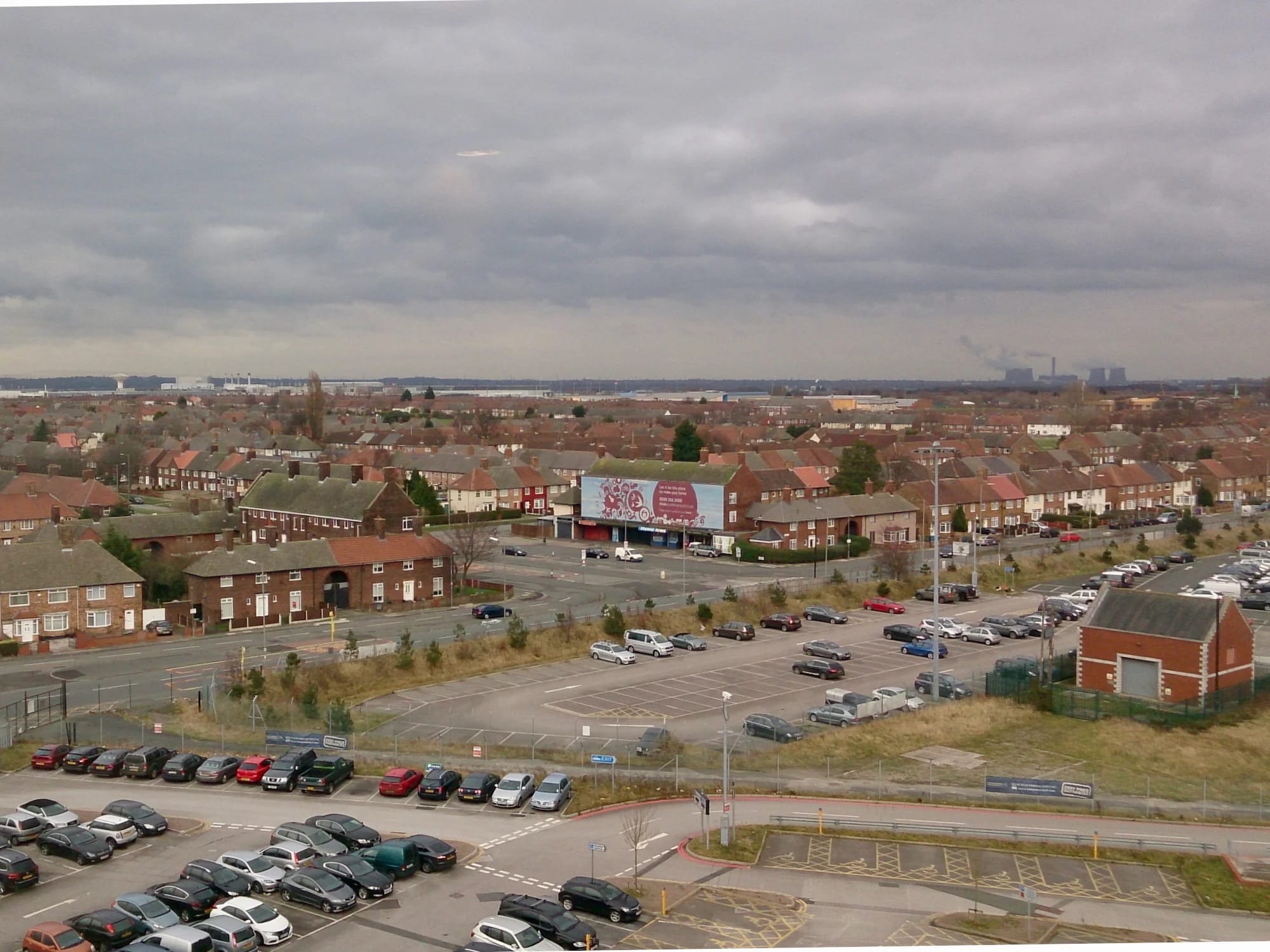Developers gave the council millions to improve Liverpool. Why haven't they spent it?

£17 million of compensation for local areas has accrued over the past two decades. Where is it?
“It’s just ludicrous — to have all that money sitting in a bank account gaining interest somewhere while Speke suffers”. I’m on a tour of Speke with Lynne Moneypenny, a small-framed woman in her 60s who — despite her meek appearance — has spent the last decade belligerently fighting for its green spaces.
She’s lived in the suburb her entire life, and has spent many an hour traipsing through its fields and parks with her border collie, Jess. Over two decades ago, she met her partner Alan in one of those fields, by Liverpool John Lennon Airport. He’d been walking his dog too, and the pair connected over their love of the outdoors.
Now, those same fields have been tarmacked over, turned into housing estates. As Lynne explains, most of the developers responsible for building these sites paid something called section 106 compensation to council, which is supposed to be used in the local community to create more green spaces, parks and other social amenities.
As we walk along Greenway Road, staring at row after row of grey buildings, it is clear this hasn’t happened. That’s why Lynne began filing Freedom of Information (FOI) requests to Liverpool Council, to find out where that compensation went. Now, with FOIs in hand, she shows me the numbers: in the past ten years alone, Speke was given over half a million pounds worth of section 106 payments — and less than 10% of it has been spent.
Speke isn’t an isolated case. Across the whole of Liverpool, £17m worth of section 106 compensation has been given by developers over the last two decades. There are similar examples across Merseyside. What’s going on? And why are councils — which regularly remind us they’re short of funds — not spending the cash they have been given?
That’s our story today, looking at one of the big questions about how Liverpool works.
But first, your briefing.
Your Post briefing
A third person has been found guilty of assault in relation to BBC Panorama’s investigation into special needs school LIFE Wirral. Located in New Brighton, LIFE Wirral opened in 2021 and offered specialist care to children with learning difficulties. However, an undercover documentary by the BBC revealed staff bullying and physically assaulting a number of pupils. The documentary triggered the arrest of three staff members — Elliott Millar, Daniel McNulty and Oliver Nugent — and the school’s closure. Both Millar and McNulty were found guilty of assault earlier this year, and this week Nugent also pleaded guilty to beating a student. Shortly after the Panorama investigation, we published a deep dive into the school’s unusual CEO, Alastair Saverimuitto — read that here.
West Derby MP Ian Byrne has called for an independent regulator to set football ticket prices, to make sure working class supporters aren’t priced out. Speaking to fellow MPs this week, Byrne said “the reality is that prices are far too high already, especially for younger fans.” Off the back of Liverpool’s huge win this weekend, he said he’d witnessed “thousands of working class supporters priced out of Anfield, with some tickets going for over £1,000.” In response, Liverpool FC said it had already frozen prices for the past eight out of 10 years, and that the cheapest Kop match ticket costs “exactly the same as [it did] almost 15 years ago.”
And LIPA's Sixth Form College has now been rated inadequate by Ofsted. In the latest assessment of the performing arts school, inspectors handed it the lowest possible rating – a huge drop from 2019, when it was rated outstanding. Charles Bartholomew, the principal of the sixth form, said the findings were "hugely disappointing" and attributed them to "an unprecedented and challenging period of industrial action".
In the first of a new series looking at some of the city's big unanswered questions, today we're investigating why the council has been given millions of pounds by developers, but hasn't been able to spend it on local areas.
What exactly is a section 106 agreement?
Despite a name that makes your eyes glaze over, section 106 agreements are a simple concept. When a developer wants to build something in the local area, they must mitigate any negative impact of that development. For example, if a developer wanted to build more housing on a field that is regularly used by residents, they would have to pay a sum of money to the council so that another community asset could be created in its place, or work on existing assets could be conducted. Each agreement is made on a case-by-case basis.
The money doesn’t just go towards green spaces. It could be affordable housing, new education or community buildings, planting trees and other general maintenance of the surrounding area. It’s up to the council and developer to decide what locals will benefit from.
Sometimes, once planning permission is granted, developers make these payments straight away. But for the majority of cases, developers will make a full payment of their section 106 contribution once they’ve finished building.
Who is owed the money?
Andrew Makinson, a Lib Dem councillor for Church, says the problems around section 106 spending have got worse in recent years. He points to one site in his ward: the former New Heys School, which closed in the early 2000s. When works began to turn the site into houses in 2014, £100,000 of section 106 money was allocated to the local area for flood defences. Ten years on, residents are still waiting. “Pretty much every year I've been asking [the council] when this flooding work is going to be done,” he says. “They keep saying ‘It's going to happen this year’ and then the next year, all while that money has been sitting in the bank.”
Last year, Makinson found a council report which revealed that Liverpool Council had over £17m in section 106 payments in the bank. While around £12m of that money had, according to the council, been allocated to projects, it was yet to be spent. After seeing this figure, he filed an FOI to get a full breakdown of how much section 106 money is owed to each ward in Liverpool.
After waiting a year for a response, in January he took his FOI to the Information Commissioners Office, who have ruled Liverpool Council must provide him with answers in the next 30 days.
Why is it so hard to spend this money?
The situation in Liverpool “is a microcosm of the rest of the country,” says Bob McGeady. He’s a leading planning lawyer in the UK, and has worked on major legal agreements in relation to section 106.
Earlier this month, the BBC reported that Medway Council had more than £20m in unspent funds, and last year a report by the Homebuilder's Federation found Oxfordshire County Council with £287m in section 106 contributions sitting in the bank. In total, councils in England and Wales have accrued nearly £4bn.
“I think [the problem] comes down to bums on seats and resources,” McGeady says, noting that due to budget cuts councils have been “hollowed out”, putting them under increasing strain to get important work done. While there are still teams dedicated to overseeing section 106 agreements, this is generally to ensure the developer meets their side of the bargain. Once the money is in the councils’ hands, “that’s where the system breaks down”.

Councillor Makinson highlights another problem with our current system, too: many of the section 106 payments aren’t due until after building works are complete. And, when the council invoices for them, they’re not always paid.
Back in 2022, another FOI request revealed Liverpool Council had £6m worth of outstanding invoices from developers, many of which had gone into administration. Of course, in a city like Liverpool — with several boom and bust property developers over the last decade — it’s no wonder this is adding another layer to the issue. We asked Liverpool Council for an update on the 2022 figure for outstanding invoices, but they did not answer our question.
What happens if it doesn’t get spent?
One of councillor Makinson’s biggest concerns is a caveat that comes with section 106 payments. If they are unspent after a set time period (usually ten years), developers are entitled to claim that money back. However, McGeady stresses this is rare. “Developers aren’t chomping at the bit to get money back,” he explains. In the eyes of developers, a section 106 payment is just part of the cost of the project in the first place. Seldom are they poring over old planning applications looking to claw back pennies.
What this does leave, though, is an inflation problem. As prices rise, what you can get for the money falls. What could have been used ten years ago to fully restore a park, or build a new green space, “no longer stretches that far,” says Makinson.
And there can be a lack of “will and enthusiasm” from councils to create concrete plans on how to spend that money, McGeady says. “It calls into question why they asked for [the 106 contribution] in the first place,” he adds, noting they “should understand that there is a process that you have to go through in order to deliver.” And while it may be arduous and resource heavy, the results leave communities feeling less resentful of developers building much needed new homes.
In a statement, Liverpool Council told us that the scope for investing section 106 compensation is "tightly constrained by law, relating to the specific circumstances of the development that provided the funding, and the scope of our statutory Local Plan". They continued:
“This can mean there is a delay between the receipt of funding and its investment in communities, but the council is improving its management of those processes in order to improve the flow of investment to support the city’s priorities. As an example, the Cabinet will next week be signing off £680k of investment in children’s play areas in several of our public parks.”
So what is the solution?
The answer could lie in community involvement. Across the city there are dozens of community-led groups willing to develop plans to improve their local area, which could ease the burden on the council.
“If you get people who are sufficiently motivated in their community, then yes, of course, they should and will get involved,” McGeady says, but adds that “99.999% of the time” communities aren’t aware of what they’re entitled to, and what they can plan for.
Makinson echoes his thoughts. “Councillors don’t know there's this money in their wards that can be spent on things that residents are complaining about,” he says. He believes an accessible and publicly available list of section 106 contributions would go a long way in helping communities know what they’re entitled to, and allow them to mobilise around that money.
Until then, he says, we’ll continue to see “generations of children missing out on decent facilities.”

Comments
Latest
The watcher of Hilbre Island
A blow for the Eldonians: ‘They rubber-stamped the very system they said was broken’
How Liverpool invented Christmas
This email contains the perfect Christmas gift
Developers gave the council millions to improve Liverpool. Why haven't they spent it?
£17 million of compensation for local areas has accrued over the past two decades. Where is it?